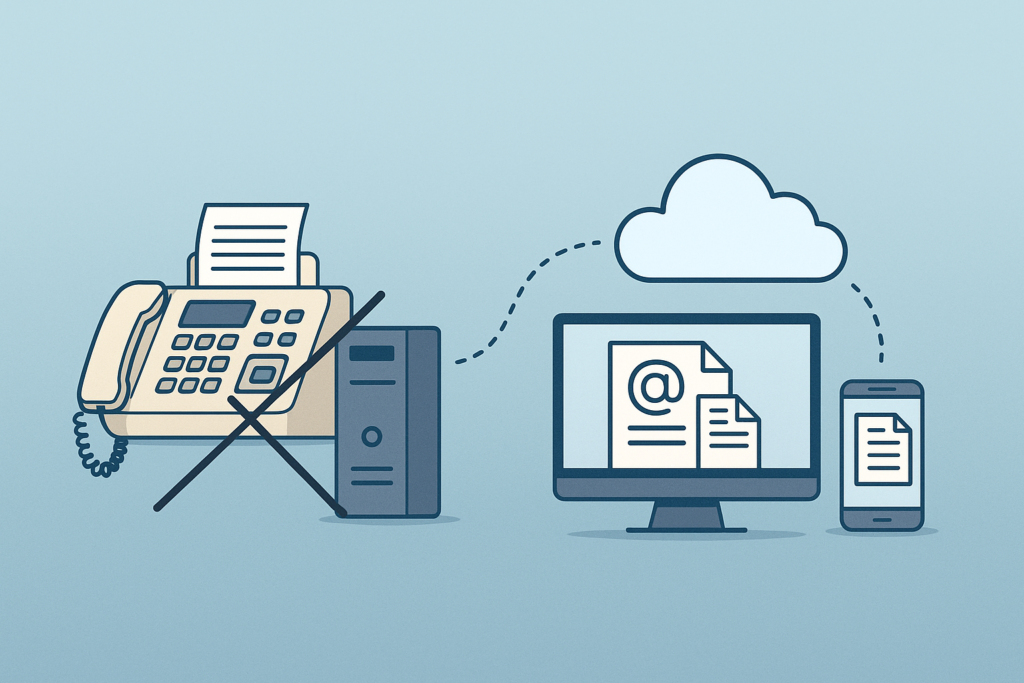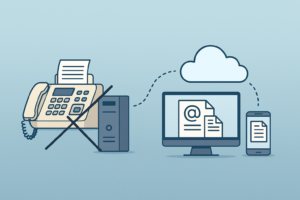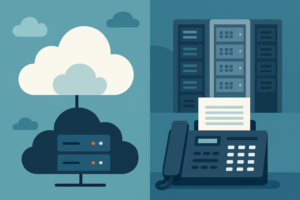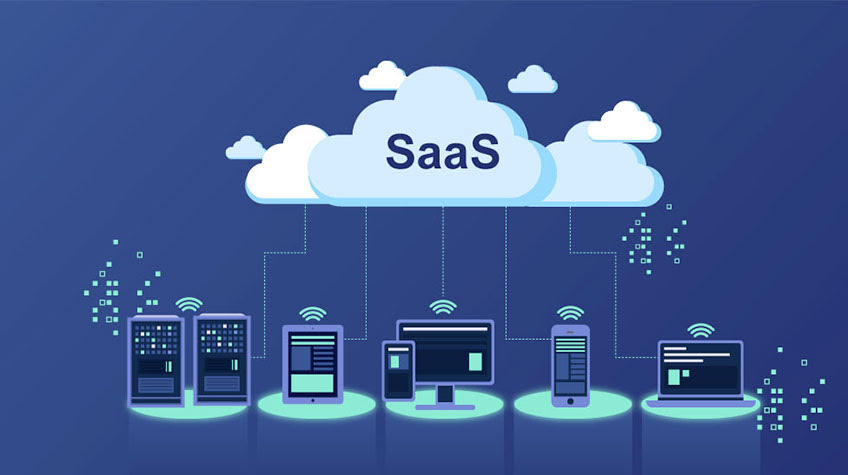When your car is old, unreliable and expensive to maintain you choose to continue maintenance or move onto a new one. When your current fax server is like that old car you have the same choice; maintain or move on. The ‘move on’ option is far simpler now as the fax server industry has consolidated and there are far fewer choices.
During the 1990s there were over 120 different fax server solutions to choose from. Thirty years later there are only two Enterprise Class fax server solutions to choose from; FaxCore or opentext’s RightFax server. Biscom, a leader in the fax server industry for decades, was acquired by Concord (a cloud-based fax service) and the Biscom FaxCom server is being wound down. All the other brands have gone out of business or were acquired and rolled up by another company in the fax server industry.
Fax Server Alternatives: Cloud vs. On-Premise Solutions
There are two replacement options: On-prem fax server software or a cloud-based fax service. FaxCore™ and opentext™ offer both and there are major differences.
FaxCore’s fax service in the cloud uses the same software that customers run on-prem. There is no loss of features when using FaxCore in the cloud. Many organizations that ran FaxCore on-prem and wanted to go cloud had a seamless transition. And most were able to lower their annual operating costs by going to FaxCore’s cloud option.
The choices from OpenText are starkly different; a 1990’s era software program – RightFax can be installed on-prem or their cloud option is Core Fax (wonder how they thought of that name) which is a rebranding of the Xmedius fax server. Neither option provides a rich user experience.
When comparing the two companies’ offerings, these are critical factors to consider.
Is Cloud Faxing Right for Your Business?
If not, then the fax server application must reside within your environment on Virtual Machines or physical servers. The operating system required by FaxCore and RightFax is Microsoft’s Window Server operating system and the Microsoft SQL database.
Next comes the Telco component of a fax server. The major Telcom players (AT&T, Lumen, Verizon, etc.) have largely shut down their legacy copper telephone network. That leaves the choice of SIP Trunks and Voice over IP services or an IP Based phone system, such as Avaya. Once the SIP Trunks are available (from an IP PBX or Telco) the fax drivers (software) that actually place/answer the fax call using Fax over IP is the next component. RightFax has their own bundled FoIP drivers whereas FaxCore uses the Dialogic SR140 drivers or the XCAPI drivers from TE Systems.
If the fax server solution will reside in a 3rd party datacenter the Telco options may be limited. Procuring SIP Trunks and setting up an SBC is difficult, time consuming and costly.
Most organizations who host the fax server application in a third-party datacenter choose a hybrid, or ‘Partly Cloudy’ implementation where the fax modem and Telco are in the cloud. FaxCore pioneered this concept of an on-prem fax server connecting to the phone lines and fax modems in the cloud. This Partly Cloudy approach has the advantage of being HIPAA and PCI compliant solution since the fax images are not stored in the cloud. The faxes are encrypted and stored by the FaxCore fax server in your datacenter.
Changing fax server providers also opens the possibility of moving to the cloud, or a different cloud based fax service.
The fax service in the cloud is more than just addressing concerns about data security and regulatory compliance.
- FaxCore’s cloud option includes all the features and functionality as FaxCore’s on-premise software. Other providers of cloud-based faxing have a very stripped down UI for sending and receiving faxes.
- When the fax service is in the cloud, how can received faxes load into your on-premise healthcare applications, securely?
- Is the use of email to send and receive faxes secure enough to be compliant with PCI and HIPAA?
- FaxCore has a REST API so documents can be transferred between applications, securely and automatically.
- Are the datacenters used by the fax service located in the US?
- Can users authenticate using SSO and integration with Microsoft’s Active Directory?
- Are other forms of Identity Access Management available?
- What is the retention for faxes stored in the fax service?
Sending a fax is as easy as sending an email.
Sending a fax from PC can be done by sending an email to [email protected], as an example. And that works from a printer (MFP) by scanning the document and sending in by email, using the same syntax of [email protected].
Many industry specific applications have APIs that are used to integrate with fax servers so there is no user involvement with the actual fax server application to send or receive a fax. Chances are good that your application will have an integration with RightFax or FaxCore.
Other processes can include a fax being created from within an application like MS Word and simply printing the document to FaxCore’s IP Fax Printer to create a fax job and send it.
All fax server applications offer a user interface, some more user friendly than others when it comes to sending faxes, monitoring the status of faxes sent and to access received faxes. FaxCore makes it easy to assemble different documents from different applications and combine them into a single fax transmission. This is a feature that is unique to FaxCore and a common requirement.
Fax jobs can be created and submitted with a status of ‘Hold’ so they can be reviewed by the sender or a manager, before being released and sent. Faxes can also be scheduled for a later delivery date or time. This feature is helpful when a recipient’s fax lines are very busy during the day.
Managing High-Volume Faxes: Splitting, Tracking, and Workflow Integration
It’s not unusual to receive a fax that contains 800 pages, or even more. Then the information in the fax needs to be entered into the appropriate application. A very useful feature to facilitate ‘workflow’ processes is being able to split the fax into separate files that organize the appropriate pages for delivery into another healthcare application.
Editing and saving the fax in the fax server application is a must and advanced features such as page splitting, adding tracking data, forwarding the fax to another user or fax number and saving the fax into specific folders are critical. For HIPAA compliance an audit trail must be retained that documents all activities related to that fax message.
Numerous companies have created software solutions that provide automated processing of faxes in order to reduce data entry, data entry mistakes, facilitate workflow processes and archival of the faxes. Explore integration options are available for your EMR/EHR application and consult with your fax service provider about additional possibilities and integrations already in place that are being used successfully.
My faxes are in the cloud. How do they get out of the cloud and into my apps?
The Internet made the moving documents around easy with options leveraging email, DropBox, and other file sharing services. Not all meet HIPAA and PCI security requirements and all require a person manually creating the transaction. That’s OK for an occasional document but what about hundreds or thousands of faxes coming in every day that must move from the cloud to the ground (your servers) securely.
Then add in roadblocks like firewalls and user account credentials. Microsoft created great utilities that will synchronize folders in their Azure datacenter with folders on servers in your network, securely. FaxCore has been deploying these technologies for years with 100% uptime and 100% reliability.
Conclusion: Why FaxCore is a Future-Proof Fax Server Replacement
Moving to the cloud is the preferred model now. Organizations want to reduce on-prem software and put it in the cloud. FaxCore, being built in and for the Internet age has been able to offer cloud faxing before the cloud was ‘a thing’.
The best outcome is working with a supplier that has their operations in the US and in datacenters from Microsoft (Azure). The Azure datacenters facilitate the management of users, IAM and SSO. Lastly, avoid long-term contracts. Fax usage varies from month-to-month and year-to-year. Don’t lock into a fixed expenditure if you think your faxing volume may decline.





